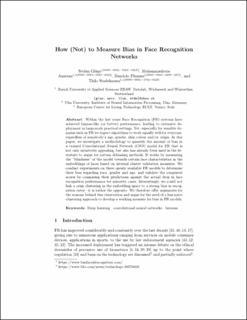Please use this identifier to cite or link to this item:
https://doi.org/10.21256/zhaw-20277| Publication type: | Conference paper |
| Type of review: | Peer review (publication) |
| Title: | How (not) to measure bias in face recognition networks |
| Authors: | Glüge, Stefan Amirian, Mohammadreza Flumini, Dandolo Stadelmann, Thilo |
| et. al: | No |
| DOI: | 10.21256/zhaw-20277 10.1007/978-3-030-58309-5_10 |
| Proceedings: | Artificial Neural Networks in Pattern Recognition |
| Editors of the parent work: | Schilling, Frank-Peter Stadelmann, Thilo |
| Conference details: | 9th IAPR TC 3 Workshop on Artificial Neural Networks for Pattern Recognition (ANNPR'20), Winterthur, Switzerland, 2-4 September 2020 |
| Issue Date: | 2-Sep-2020 |
| Series: | Lecture Notes in Computer Science |
| Series volume: | 12294 |
| Publisher / Ed. Institution: | Springer |
| Publisher / Ed. Institution: | Cham |
| Language: | English |
| Subjects: | Deep learning; Convolutional neural network; Fairness |
| Subject (DDC): | 006: Special computer methods |
| Abstract: | Within the last years Face Recognition (FR) systems have achieved human-like (or better) performance, leading to extensive deployment in large-scale practical settings. Yet, especially for sensible domains such as FR we expect algorithms to work equally well for everyone, regardless of somebody's age, gender, skin colour and/or origin. In this paper, we investigate a methodology to quantify the amount of bias in a trained Convolutional Neural Network (CNN) model for FR that is not only intuitively appealing, but also has already been used in the literature to argue for certain debiasing methods. It works by measuring the "blindness" of the model towards certain face characteristics in the embeddings of faces based on internal cluster validation measures. We conduct experiments on three openly available FR models to determine their bias regarding race, gender and age, and validate the computed scores by comparing their predictions against the actual drop in face recognition performance for minority cases. Interestingly, we could not link a crisp clustering in the embedding space to a strong bias in recognition rates|it is rather the opposite. We therefore offer arguments for the reasons behind this observation and argue for the need of a less naive clustering approach to develop a working measure for bias in FR models. |
| URI: | https://digitalcollection.zhaw.ch/handle/11475/20277 |
| Fulltext version: | Accepted version |
| License (according to publishing contract): | Licence according to publishing contract |
| Departement: | Life Sciences and Facility Management School of Engineering |
| Organisational Unit: | Institute of Computer Science (InIT) Institute of Applied Mathematics and Physics (IAMP) Institute of Computational Life Sciences (ICLS) |
| Published as part of the ZHAW project: | Libra: A One-Tool Solution for MLD4 Compliance |
| Appears in collections: | Publikationen Life Sciences und Facility Management Publikationen School of Engineering |
Files in This Item:
| File | Description | Size | Format | |
|---|---|---|---|---|
| 2020_Gluege-etal_Bias-in-face-recognition-networks_ANNPR.pdf | Accepted Version | 3.78 MB | Adobe PDF |  View/Open |
Show full item record
Glüge, S., Amirian, M., Flumini, D., & Stadelmann, T. (2020). How (not) to measure bias in face recognition networks [Conference paper]. In F.-P. Schilling & T. Stadelmann (Eds.), Artificial Neural Networks in Pattern Recognition. Springer. https://doi.org/10.21256/zhaw-20277
Glüge, S. et al. (2020) ‘How (not) to measure bias in face recognition networks’, in F.-P. Schilling and T. Stadelmann (eds) Artificial Neural Networks in Pattern Recognition. Cham: Springer. Available at: https://doi.org/10.21256/zhaw-20277.
S. Glüge, M. Amirian, D. Flumini, and T. Stadelmann, “How (not) to measure bias in face recognition networks,” in Artificial Neural Networks in Pattern Recognition, Sep. 2020. doi: 10.21256/zhaw-20277.
GLÜGE, Stefan, Mohammadreza AMIRIAN, Dandolo FLUMINI und Thilo STADELMANN, 2020. How (not) to measure bias in face recognition networks. In: Frank-Peter SCHILLING und Thilo STADELMANN (Hrsg.), Artificial Neural Networks in Pattern Recognition. Conference paper. Cham: Springer. 2 September 2020
Glüge, Stefan, Mohammadreza Amirian, Dandolo Flumini, and Thilo Stadelmann. 2020. “How (Not) to Measure Bias in Face Recognition Networks.” Conference paper. In Artificial Neural Networks in Pattern Recognition, edited by Frank-Peter Schilling and Thilo Stadelmann. Cham: Springer. https://doi.org/10.21256/zhaw-20277.
Glüge, Stefan, et al. “How (Not) to Measure Bias in Face Recognition Networks.” Artificial Neural Networks in Pattern Recognition, edited by Frank-Peter Schilling and Thilo Stadelmann, Springer, 2020, https://doi.org/10.21256/zhaw-20277.
Items in DSpace are protected by copyright, with all rights reserved, unless otherwise indicated.